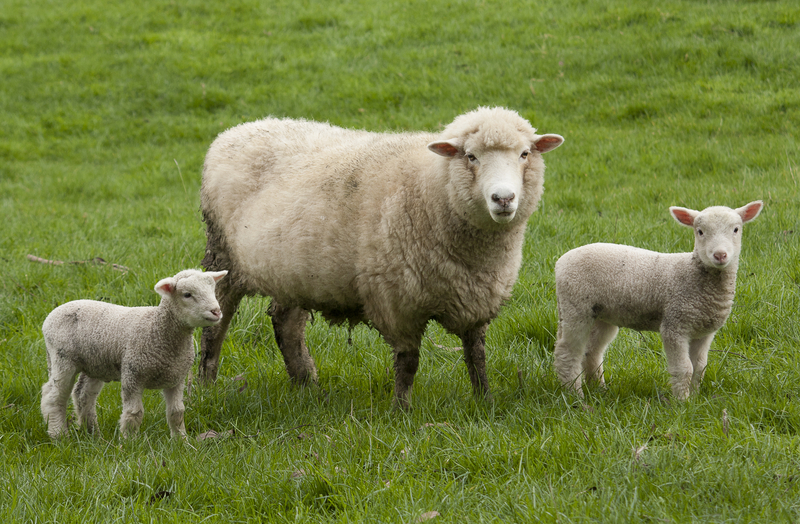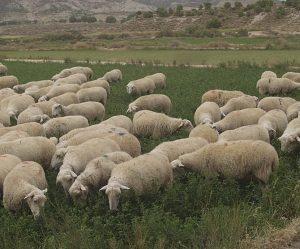 22 Aug 2022
22 Aug 2022
Ewe nutrition, and the need to understand its importance for the development of sustainable productive systems.
Introduction
Feed and forage account for more than 50% of the total variable costs of a sheep enterprise, so it is crucial that feed is high quality and gives the animals the nutrients they need when they need them. Reducing costs deliberately without a previous analysis can lead to health and production problems. Nutrients are required for maintenance, growth, lactation, reproduction and health. Deficient nutrition can lead to fertility issues, poor lamb survival, low growth rates, and can contribute to ewe and lamb mortality. Good ewe nutrition is vital for successful flock performance. The feed requirements of ewes vary significantly depending on their stage of production so feeding regimes must takes this into consideration.
Maximized forage use reduces the amount of concentrate that is required. Therefore, implementing silage or hay analysis is essential for assessing forage quality, and to accurately formulate diets. The assessment of body condition is the best tool for corroborating ewes’ health and the adequacy of their diet. This is highly significant to improve the flock’s performance from a health status and productive standpoint.
The following entry reviews important aspects of ewe feeding and include some of the latest advances on this matter.
Sheep feeding is based on the principle of feeding the rumen microflora, which in turn will feed or nurture the sheep with their byproducts. The rumen allows sheep to digest fiber, which is possible due to the presence of millions of bacteria, protozoa and fungi (microflora). Therefore, it is highly important for this relationship to be preserved and well understood.
Like all young ruminants, when milk is the main component of their diet, lambs depend on the abomasum for nutrient digestion. The rumen develops with age but its development is highly dependent on the diet. It is considered, that approximately at 8–10 weeks of age the rumen is completely functional.
Energy
Energy is often the limiting factor in sheep diets. It can be provided in three different forms: fiber, sugar and starch.
The rumen needs a balance of all three, but the amounts vary depending on the stage in the ewe’s production cycle.
The daily energy requirements of ewes can usually be met with grazing alone. However, when the quality of grass or its supply is somewhat deficient, extra feed may be necessary. This is especially true under extreme weather conditions or under highly demanding physiological states such as late pregnancy and lactation.
Ruminal microflora use these three energy sources for their growth and in turn produce volatile fatty acids (VFAs). These are absorbed across the rumen wall, enter the ewe’s bloodstream and travel towards the liver where they are used as energy sources.
Figure 1:Rumen inputs and outputs

Protein
Ewes meet their protein requirements from two sources:
• Rumen Degradable Protein (RDP)
• Digestible Undegradable Protein (DUP) – Also known as bypass
protein as it is not digested in the rumen.
Ewes have a daily requirement for RDP which is readily found in grass, hay, silage, green leafy brassicas and many other feedstuffs. It is used by the rumen microflora to reproduce and then some of them are swept out into the small intestine for digestion. This is called microbial protein and is the most important source of protein for ruminants. It is essential that the microflora have enough degradable protein in the diet.
RDP is usually enough to meet the ewe’s protein requirements. However in late pregnancy this often cannot be met from RDP in forage alone. This is both due to reduced rumen capacity as the uterus enlarges and an increased need for protein to grow the lambs and produce milk.
This gap can be filled by feeding some high-quality DUP such as soybean meal. Some of the protein in this type of supplement is less degradable in the rumen, so it passes through unaltered and is then absorbed in the intestine.
DUP requirements are especially important for ewes carrying multiple lambs during the last three weeks of pregnancy.
Grazing
Grass is chewed a little before it is swallowed and enters the rumen. Some of the sugars in the grass are used by the
microflora for energy, which helps them break down RDP ready for it to be transformed into more microflora.

Ruminating
Before feed reaches the rumen, breakdown has started by the initial chewing process.Rumination (or chewing the cud) returns the feed to the mouth for further chewing. This is often done when the ewes are lying down.
The time spent ruminating depends on the fiber content of the diet; the more fibre there is, the longer the ewe will ruminate. This process breaks the feed down into smaller particles, which increases the surface area for the microflora to work on…..
This entry will continue on a subsequent publication….
Source: Abstract taken from “Improving ewe nutrition for Better Returns.”
Subscribe now to the technical magazine of animal nutrition
AUTHORS

Nutritional Interventions to Improve Fertility in Male Broiler Breeders
Edgar Oviedo
The Use of Organic Acids in Poultry: A Natural Path to Health and Productivity
M. Naeem
Synergistic Benefits of Prebiotics and Probiotics in Poultry, Swine, and Cattle
Gustavo Adolfo Quintana-Ospina
Hybrid Rye Potential in Laying Hen Feed Rations
Gwendolyn Jones
A day in the life of phosphorus in pigs: Part I
Rafael Duran Giménez-Rico
Use of enzymes in diets for ruminants
Braulio de la Calle Campos
Minerals and Hoof Health in the Pregnant Sow
Juan Gabriel Espino
Impact of Oxidized Fats on Swine Reproduction and Offspring
Maria Alejandra Perez Alvarado